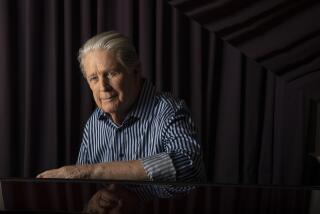Wilson Has Sharks Speaking His Language
- Share via
SAN JOSE — Ron Wilson’s first gadget was a typewriter. He pecked away for hours in his grandfather’s office at Canadian Pacific Railway.
His interests in electronics grew every year -- particularly when he made enough money as a hockey player to afford the coolest stuff. Just check out Wilson’s home theater system in South Carolina, which is so complicated that only he can use it.
“I’m the type of guy who’s always got to have the new thing,” he said.
And Wilson’s technological savvy is all over the best season in franchise history for the San Jose Sharks, who have reached the Western Conference finals in Wilson’s first full season as their coach.
Wilson and his assistants, Tim Hunter and Rob Zettler, constantly invent ways to make the Sharks better and smarter. They compile obscure databases, dissect game tapes and preach strategy with rinkside computers, personalized scouting reports and a wealth of digital, wireless gadgetry.
“It’s just good to take advantage of any edge that information or technology can give you,” Wilson said. “I don’t make decisions based on what my computer spits out, but you’d be foolish if you don’t use everything at your fingertips for a competitive advantage.”
Wilson honed his coaching innovations during previous stops in Vancouver, Anaheim and Washington, but he has pulled all of his knowledge together in a multidimensional teaching approach for Silicon Valley’s favorite hockey team.
The Sharks have a computer monitor on their bench for replays and strategy questions, and they keep a tablet PC handy for instant statistical checks. Their locker room features a “SMART Board” -- essentially the world’s most sophisticated chalkboard, which includes video streaming and telestrator capabilities.
The Sharks also take their technology on the road. In addition to the staff’s laptops, they travel with a black trunk that contains a video screen, DVD burners, VCRs, computer equipment and thousands of hours of game footage.
“We get a lot of cool stuff from the coaching staff,” center Alyn McCauley said. “Ron’s always coming up with something, and sometimes it’s pretty amazing what they can show you or what they know.”
In addition to these teaching advantages, the coaches compile statistics with a zeal that nearly matches baseball’s sabermetricians. Want to cross-reference shift lengths against goal-scoring in every month of the season? Wilson can look it up on FileMaker Pro -- a database software program usually used by accountants.
Hunter was one of the NHL’s toughest forwards during 10 seasons with the Calgary Flames, but he does his best work these days in front of a keyboard and a monitor. Though Hunter’s oft-broken nose marks him as a tough guy, he’s just as savvy as his boss, expounding on digital-analog conversions for game tapes with the expertise of the nerdiest electronic-store clerk.
“We’ve had to replace the keyboard like 15 or 20 times,” Wilson said when Hunter was within earshot. “He’s not delicate.”
The NHL is steeped in reverence for the traditions of old-time hockey, and Wilson knows the game’s heritage as well as anyone. His father and uncle won Stanley Cups playing for the Detroit Red Wings, and Wilson played parts of six seasons in the league, along with extensive international experience.
Wilson acknowledges a debt in navigating that divide to Hall of Fame coach Roger Neilson, known as “Captain Video” for helping introduce tape study into the sport. Neilson’s approach caught on while Wilson was a player.
Neilson “got me interested in it -- his approach to breaking a game down,” Wilson said. “Scoring chances, shift statistics, stuff that nobody had ever heard of, or even thought about.”
Wilson first attempted to blend technology with hockey when he was an assistant coach with the Canucks from 1990-93. His first boss, Bob McCammon, thought the extensive video scouting was a waste of time -- but when Pat Quinn replaced McCammon, the current Maple Leafs coach encouraged Wilson to pursue all manner of innovation.
Rob Scichili worked for the Mighty Ducks’ public relations department during their inaugural season, Wilson’s first as a head coach. Scichili remembers Wilson’s passion for everything from electronic gadgets and e-mail to extensive video analysis, used by the Ducks’ coaching staff for advance scouting.
“Ron was into the Internet before it was hip,” said Scichili, now the Dallas Stars’ senior director of hockey communications. “Every time the team was on the road, he would be up early on the Internet looking up articles on other teams. He was operating the way we do now, back in 1993-94, the Ducks’ first year.
“His love for gadgetry was contagious. The other coaches got interested. Even I got interested.”
The Sharks don’t make personnel decisions based on the coaches’ data, so it’s not quite the “Moneyball” approach of the Oakland Athletics’ Billy Beane and his disciples, who have reshaped baseball scouting with their numbers-based theories.
Wilson prefers not to use his numbers against his players -- instead counting on the data to reinforce his gut instincts from a lifetime of hockey.
His players soon discover the numbers don’t lie.
Back in Anaheim, journeyman Todd Krygier insisted he was just as effective on the penalty-kill as Paul Kariya, until Wilson showed him statistics that decisively proved otherwise.
“Todd got me really focused on finding some real numbers to back up what I was doing on feel,” Wilson said. “I’m not a sabermetrician, or believe in it to that extent, but they’ve been doing this in baseball for a while now.
“We’ve got numbers in hockey too. It’s just that nobody is using them.”
More to Read
Go beyond the scoreboard
Get the latest on L.A.'s teams in the daily Sports Report newsletter.
You may occasionally receive promotional content from the Los Angeles Times.






